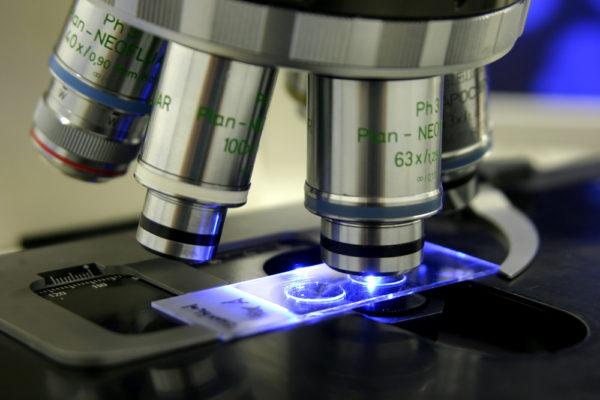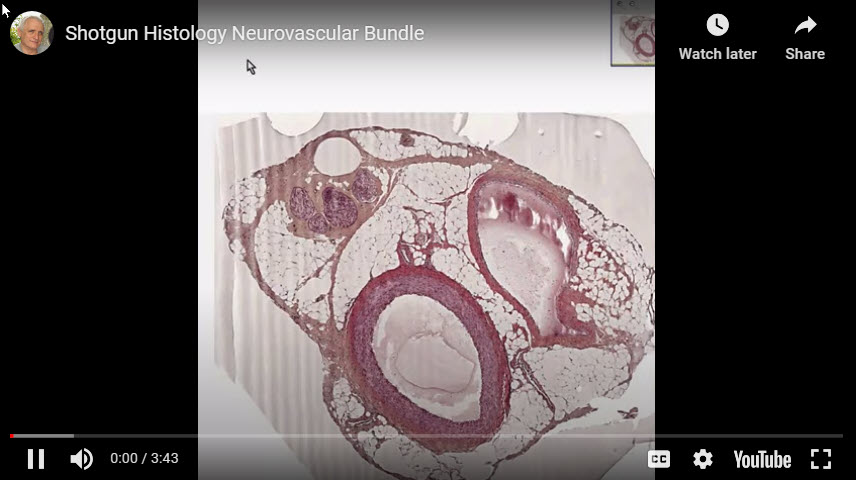Human body tissues
One of the most difficult sessions of human anatomy lab for beginning students is tissue anatomy. That is, learning to identify human body tissues under the microscope or by studying photomicrographs.

Tissue slide on microscope stage. Focus in on what your need to see for anatomy practical, Sven Hoppe/Shutterstock.com
First, just finding the tissue in the viewer of the microscope is a challenge.
Would it not be nice to have your own personal pathologist to explain what you are supposed to be seeing?
Well, this is available on YouTube from a pathologist branding himself Shotgun Pathology. Dr. John Minarcik has produced over 800 short videos describing human tissue in detail. Below are links to those of his videos that I think will be most helpful to human anatomy students.
There are too many videos for me to embed them all in this page. But here is an example of what his videos are like. This is Dr. Minarcik’s discussion of a neurovascular bundle.
It is sometimes missed when studying muscles, nerves, arteries and veins separately that the nerves and vasculature course through muscle together as vascular bundles.
I stumbled upon Dr. Minarcik’s material as I was searching YouTube for videos on human tissue histology. Some years ago, when I worked in academic medicine and I needed to understand tissue histology, I always talked a pathologist into spending a little time with me at the double headed microscope.
Do not miss this opportunity to review human tissue histology with Dr. Minarcik before you study human body tissues under the microscope or in photomicrographs yourself.
* Elastic Cartilage [1:59 minutes]
* Hyaline Cartilage [4:26 minutes]
* Fibrocartilage [1:59 minutes]
* Dense Regular Connective tissue [2:22 minutes]
* Areolar Connective Tissue [5:45 minutes]
* Adipose Tissue [3:15 minutes]
* Spongy Bone [4:06 minutes]
* Dense Bone [6:11 minutes]
* Bone Marrow [2.38 minutes]
* Three Muscle Types [6:20 minutes]
* Heart Endo-, Peri-, Epicardium [2:29]
* Heart Purkinje Fibers [1:39 minutes]
* Nerve Fiber [2:49 minutes]
* Thin Skin [9:58 minutes]
* Lung [6:55 minutes]
* Trachea [5:11 minutes]
* Kidney [9:01 minutes]
* Liver [6:43 minutes]
Further reading
Memory, Patterns and Themes in Anatomy and Physiology
Do you have questions?
Please put your questions in the comment box or send them to me by email at DrReece@MedicalScienceNavigator.com. I read and reply to all comments and email.
If you find this article helpful share it with your fellow students or send it to your favorite social media site by clicking on one of the buttons below.
Margaret Thompson Reece PhD, physiologist, former Senior Scientist and Laboratory Director at academic medical centers in California, New York and Massachusetts is now Manager at Reece Biomedical Consulting LLC.
She taught physiology for over 30 years to undergraduate and graduate students, at two- and four-year colleges, in the classroom and in the research laboratory. Her books “Physiology: Custom-Designed Chemistry”, “Inside the Closed World of the Brain”, and her online course “30-Day Challenge: Craft Your Plan for Learning Physiology”, and “Busy Student’s Anatomy & Physiology Study Journal” are created for those planning a career in healthcare. More about her books is available at https://www.amazon.com/author/margaretreece. You may contact Dr. Reece at DrReece@MedicalScienceNavigator.com, or on LinkedIn
Dr. Reece offers a free 30 minute “how-to-get-started” phone conference to students struggling with human anatomy and physiology. Schedule an appointment by email at DrReece@MedicalScienceNavigator.com.



Just strolled on your website. Thank you for the invite but I will be surfing here late next year for I will be busy studying for my Diplomate Examination in Pathology. Again thank for your invite hope to hear from you too. 🙂
Best of luck with your Diplomate Examination in Pathology. Come back here and stroll around anytime. I should have a lot more good material up by next year.
I have recently started a site, the info you provide on this site has helped me tremendously. Thanks for all of your time & work.
Thank you for an invitation to your website as well as for giving your freshly published book for free download on Amazon! That is a really incredible opportunity to gain some brand new, fresh scientific information from the first hands. It helped me a lot in my physiology, pathology and other courses, because it gave different view of the subject than textbooks we use and it helped me to settle and broaden my knowledge. Thank you for your time and work!
Hello! I’ve been following your blog for some time
now and finally got the bravery to go ahead and give you a shout out from Austin Tx!
Just wanted to mention keep up the excellent work!